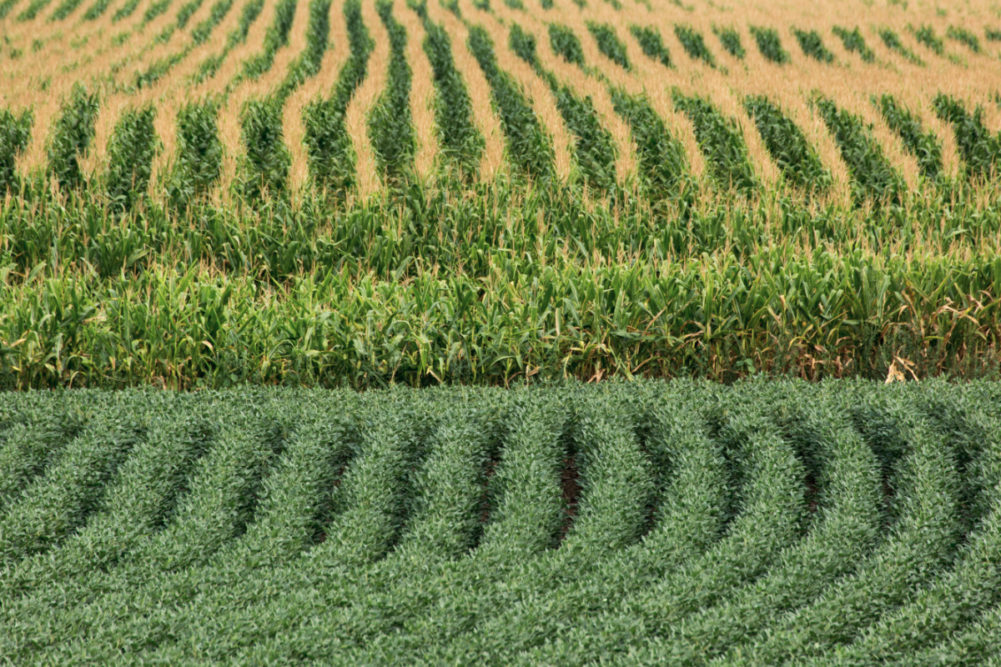WASHINGTON, DC, US — The US Department of Agriculture (USDA) in its September Crop Production and World Agricultural Supply and Demand Estimates reports lowered its forecast for US 2023 soybean production, yield and ending stocks. At the same time, the USDA raised its forecast for 2023 corn production despite a lower yield estimate on an increase in expected harvested acres.
US 2023 soybean production was forecast at 4.15 billion bushels, down 1% from 4.21 billion bushels forecast in August and down 0.7% from 4.28 billion bushels in 2022. Corn production for grain was forecast at 15.13 billion bushels, up 0.2% from 15.11 billion bushels forecast in August and up 10% from 13.73 billion bushels in 2022, the USDA said in its Sept. 12 Crop Production report.
“We’re seeing the effects of August weather reflected in these numbers, a smaller decline in corn than soybeans, but that’s to be expected,” said Bill Lapp, founder and president of Advanced Economic Solutions, Omaha, Nebraska, US. “Corn is more of a July crop, soybeans more an August crop in terms of when crops can be most adversely impacted by disadvantageous climatological conditions. Also, it appears more corn and soybean acres were planted in 2023 than previously thought.”
The USDA soybean number was near the low side of the range of pre-report trade estimates and below the average guess of 4.15 billion bushels. The USDA corn number topped pre-report trade estimates that ranged from 14.76 billion to 15.13 billion bushels.
The risk of a production decline in the USDA’s next estimate on Oct. 12 is greater for soybeans than for corn, Lapp said.
“There’s an adage that big crops get bigger and small crops get smaller, but it doesn’t always hold,” he said. “Corn was pretty far advanced so impact from heat and dryness was limited, although there could be an impact if it gets wet during harvest, but that seems like a far-fetched idea with rain seemingly turned off everywhere. It’s a building stocks situation for corn and fairly tight balance sheet for soybeans, and that’s reflected in a corn-soybean ratio (number of bushels of corn to equal the price of one bushel of soybeans) of near 2.9 to 1 versus a normal range between 2.3 and 2.7 to 1.”
In its WASDE report, the USDA estimated the carryover of corn on Sept. 1, 2024, at 2.22 billion bushels, up 19 million bushels, or 0.9%, from August and up 53% from a downwardly revised 2023 carryout of 1.45 billion bushels. Accounting for the 2024 corn adjustment was a 5-million-bushel cut to beginning stocks estimates more than offset by a 23-million-bushel increase in projected production. The Department projected the carryover of soybeans on Sept. 1, 2024, at 220 million bushels, down 25 million bushels, or 10%, from August and down 30 million bushels from a downwardly revised 250 million bushels in 2023. The 2024 soybean carryout adjustment reflected a 70-million-bushel cut to total supply and a 45-million-bushel cut to total use.
Based on Sept. 1 conditions, the average soybean yield was forecast at 50.1 bushels per acre, down from 50.9 bushels per acre in August but above 49.5 bushels an acre in 2022. Harvested area was forecast at 82.8 million acres, up 0.1% from the August forecast but down 4% from 86.3 million acres in 2022.
Corn yield was forecast at 173.8 bushels per acre, down 1.8 bushels from 175.1 bushels per acre as the August forecast but up 0.5 bushels from 173.3 bushels per acre in 2022. Harvested area was forecast at 87.09 million acres, up 0.9% from the August forecast and up 10% from 79.2 million acres in 2022.
The USDA soybean yield number was below the average pre-report trade forecast of 50.2 bushels per acre and the USDA corn yield estimate was above the trade average of 173.5 bushels per acre. Both corn and soybean yield forecasts would be the highest in seven years.
In its monthly update to world supply and demand estimates, the USDA raised its forecast for China’s soybean imports in 2022-23 to 102 million tonnes from 100 million tonnes in August and raised its expectation for China’s 2023-24 soybean imports to 100 million tonnes from 99 million in August.
“It continues to be the case that China’s import demand is pretty strong and fairly impressive,” Lapp said.
Corn and soybean futures declined after the reports were released.
“Yield was within the range of expectations, but the magnitude of the corn acreage increase was larger than the trade expected,” Lapp said.
US 2023 rice production was forecast at 220.91 million cwts, up 8% from 203.64 million cwts in August and up 38% from 160.37 million cwts in 2022.
Sorghum production in 2023 was forecast at 381.22 million bushels, down 3% from 393.31 million bushels in August but up 103% from 187.79 million bushels in 2022.






